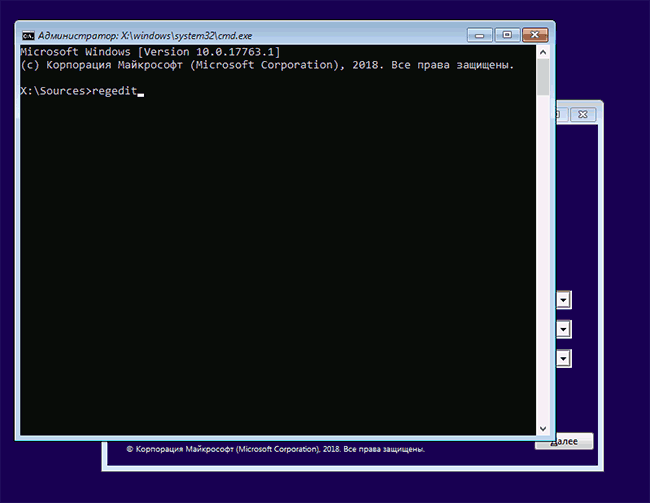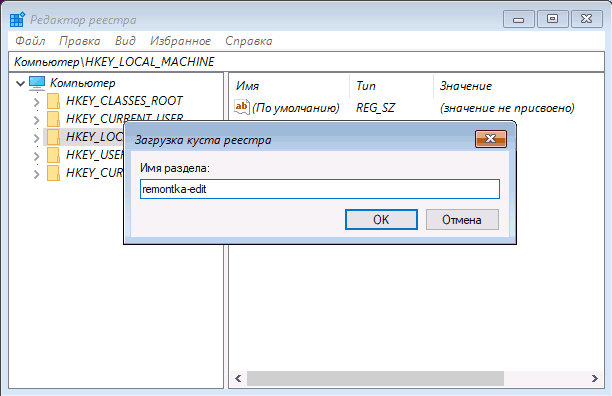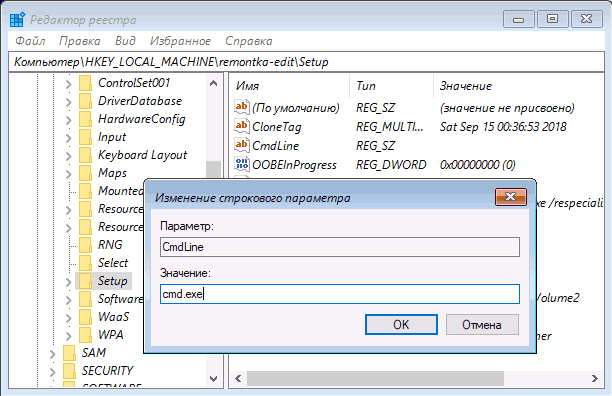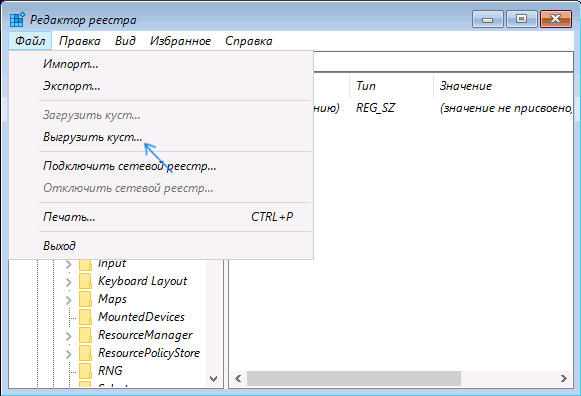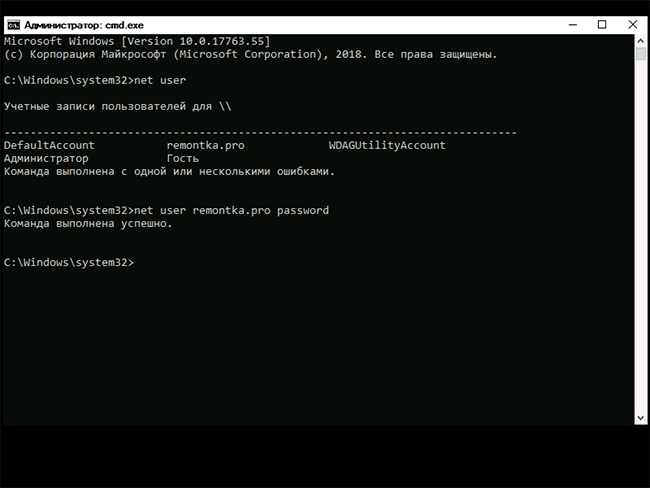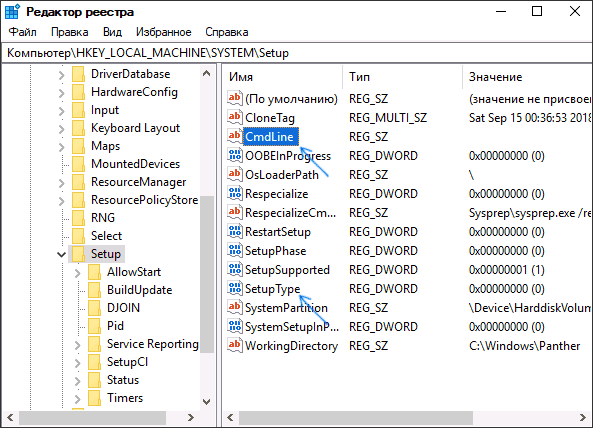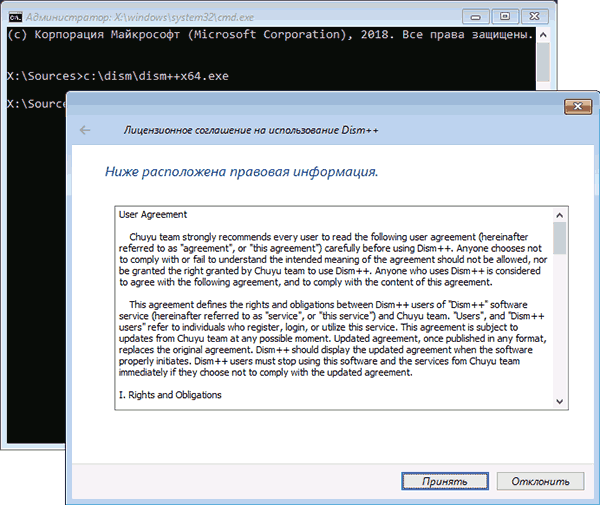
Image Credit:
Compassionate Eye Foundation/DigitalVision/GettyImages
Everything you do in Windows is stored somewhere. Much of it is in the Windows registry, which can be changed in the registry editor. However, it’s important to understand just how sensitive the registry editor is before you start trying to work in there. In fact, even one slip-up in the registry editor can seriously damage your operating system. For that reason, experts recommend backing up the registry before you start making changes. But you can search the registry at any time without making changes, as long as you know how to get in there. One of the many things you can look up in the registry are your passwords.
Find Windows 10 Password in Registry
You can conduct a Windows reset password in registry editor, but you’ll first need to find out what the password is. To find Windows 10 password in registry, you’ll first go to the registry editor. Do this by pressing «Windows» + «R.» Then you’ll type in «regedit» when you get the «Run» dialogue box. Press «Enter» to open up the registry editor to find Windows 10 password in registry. To get to the password, navigate to HKEY_LOCAL_MACHINE\SOFTWARE\Microsoft\Windows NT\CurrentVersion\Winlogon and scroll down to «DefaultPassword.» When you double-click on that, a window should pop up that reveals the stored password. This same process will work with Windows 8 and 7.
Change Password Using Registry
There are easier ways, but if you’re interested in doing a Windows reset password in registry editor, it’s probably because you’ve been locked out. If you can’t even get in to find your administrator password in Windows 7 regedit or Windows 10 regedit, you can reset your password without even being logged in. You’ll just need a bootable disk that has a setup to allow you to find an administrator password in Windows 7 regedit or Windows 8. Just boot from the disk and press «Shift» and «F10» when you get to the Windows setup screen. The command prompt window will pop up. Type in «regedit» and «Enter,» then click on «HKEY_LOCAL_MACHINE.» Click «Find» and «Local Hive,» then select DRIVE:\Windows\System32\config\SYSTEM. Replace the drive with the drive where your Windows installation is located and give your hive a name. Go to the following key HKEY_LOCAL_MACHINE\X\Setup, replacing «X» with the hive name you just chose. Edit the «cmdline» parameter and type «cmd.exe» where it asks for «Value Data.» Change the «Setup Type» to «Value Data 2,» select the hive you name you chose, then «Unload Hive.» Close the registry editor and wait for your computer to reboot. Eject your bootable media and type «net user» in the command prompt. You’ll then be able to set a new password by typing «net user login new_password.»
Change Windows 10 Password
The Windows reset password in registry editor is actually the more difficult way to reset a password. You can find a Windows 10 password in the registry and reset it, sure, but if you’re past the login screen, the easiest way to find and change the password is simply to go to Microsoft’s password recovery website. Follow the «I Forgot My Password» suggestion to recover your password. This will take you into the recovery process, and it also works if you’re trying to reset your Windows 7 or 8 password. Instead of trying to find your administrator password for Windows 7 in regedit and reset it, you can recover it in a few simple steps.
Ever found yourself needing to locate a Windows 10 password within the registry but didn’t know where to start? By following some straightforward instructions, you can effortlessly discover the concealed password and regain entry to your account. This tutorial is designed to walk you through the steps required to locate Windows 10 passwords in the registry.
Whether you’ve misplaced your original login details or require access to someone else’s secured computer, our guide will assist you in revealing the secret password. There’s no need to hesitate; our simple-to-follow guide makes finding the Windows 10 password in the registry a breeze! Additionally, this article offers valuable advice on enhancing your computer’s security to prevent future password dilemmas. Follow our tutorial to maximize the potential of your system!
Disclaimer: The information provided is for educational purposes only. We do not endorse or promote unauthorized access to private information or devices. Always ensure compliance with applicable laws and ethical standards. Any actions taken are at your own risk, and we disclaim liability for misuse.
1. Uncovering Your Forgotten Windows 10 Password in the Registry
If You Forgot Your Password, the Registry Might have the Answer
It can be extremely disheartening to think that you’ve forgotten the password to your Windows 10 account. Suddenly, you can’t access your own files, programs, and settings anymore. But don’t give up too quickly, as there might still be a way to recover your password. The answer might lie in the Windows 10 registry.
By changing certain registry entries, you can reset your Windows 10 password and gain access to your account again. In order to find the list of usernames and passwords stored in the Windows 10 registry:
- Open the Registry Editor by searching for the “Run” command in the Windows start menu, then typing in “regedit.”
- Search for a key called “HKEY_LOCAL_MACHINESOFTWAREMicrosoftWindows NTCurrent VersionWinlogon,” and open it.
- In the right panel, you will see an item named “DefaultPassword”. This contains the username and password you need to access your account again.
- Write down the username and password, and that’s it.
Keep in mind that the DefaultPassword data may be encrypted; in this case, you will need to know an administrator account’s password in order to uncover it. If this is an issue, you may want to explore alternative methods to regain access to your account.
2. Learn How to Find Your Forgotten Windows 10 Password
Reset Your Password Using a Password Reset Disk
Forgetting a Windows 10 password can be a huge hassle. Show your computer who the boss is and reset your password quickly and easily! One way to bypass your forgotten password is by using a password reset disk. This is a disk prepared ahead of time with your password reset information stored on it.
If you have one of these created, the process is quite simple. Begin by inserting the disk into your computer and restarting the device. When the reset process starts, you can choose your password reset disk and type in your desired new password. That’s it — your password has been reset, and you can get back to using your computer!
Use a Microsoft Account to Reset Your Password
Didn’t create a disc or have one on hand? Don’t worry — you have another way to get back into your computer. You can use your Microsoft Account to reset your password. All you have to do is tap or click the “I forgot my password” link. Enter your account name, then type in the characters you see on the screen. Then, enter your new password twice. That’s it — the password reset process is done, and you can unlock your computer without having to create a disk.
Here are some tips to keep in mind:
- Make sure you have an active internet connection.
- Include a mix of characters, numbers, and symbols in your password.
- Make sure your password is at least 8 characters long.
3. How to Easily Locate Your Windows 10 Password in the Registry
If you ever forget your Windows 10 password, it can be daunting to retrieve it without resetting your whole profile. Fortunately, there is an easier way to locate your password in the Windows registry.
Here’s how to easily recover your Windows 10 password:
- Open a Run dialogue by pressing the Windows + R keys.
- Type “Regedit” and press enter. This will launch the Registry Editor.
- Navigate to HKEY_LOCAL_MACHINESOFTWAREMicrosoftWindows NTCurrentVersionWinlogon.
- Look for the DefaultUserName key and expand it. The value next to “Name” is your user name.
- To the right of “DefaultPassword,” you will find the string of characters that is your current password.
- Once you find your password, you should copy it for further use.
- When you’re finished, you can close out of the Registry Editor.
After you have your password, you can log in to your Windows 10 profile, change your password, and secure your account. To prevent this process from being necessary in the future, use a password manager to keep track of your passwords and create complex, unique ones that are strong and secure.
4. A Step-by-Step Guide to Recovering Your Windows 10 Password from the Registry
If you have lost or forgotten the password of your Windows 10 computer, you can recover it using the Windows Registry. This method works for many users and is considered safer than third-party software.
Here is a step-by-step guide to recover your Windows 10 password from the Registry.
- Step 1: You must have access to a different user account on your computer.
This user should have administrative privileges. - Step 2: Open the Registry Editor by searching it using the Start menu.
- Step 3: Navigate toHKEY_LOCAL_MACHINESOFTWAREMicrosoftWindows NTCurrentVersionWinlogon.
- Step 4: Look for a key named”DefaultPassword” and delete it.
- Step 5: Reboot your computer. When your computer reboots, the password field will be blank.
- Step 6: You can now set a new password for your account.
This method is reliable and is generally the simplest way to reset your Windows 10 password. It is recommended that you use a strong password for your account, with a combination of lowercase and uppercase letters, numbers, and symbols.
In Windows 10, users may find themselves in need of retrieving their passwords stored in the registry for various reasons such as forgotten login credentials or password recovery. To begin the process, one must first navigate to the Windows registry by typing “regedit” in the command line window or search bar. Once in the registry, users can locate a wealth of password information including Administrator passwords, login passwords, WiFi passwords, and more.
By accessing the registry database and external registry hives, users can extract essential passwords with the help of powerful tools and detailed steps. It is important to note that accessing these passwords may require physical access to the device and a certain level of technical expertise. While there are various methods and tools available for password extraction, it is crucial to follow ethical guidelines and legal practices when retrieving password information from the registry. (Source: Microsoft Support)
Finding a Windows 10 password in the registry can be a daunting task, but with the right tools and knowledge, it is possible to locate and retrieve this information. By accessing the regedit tool and searching for keywords such as “windows password” or “admin password,” users can uncover valuable data stored within the operating system.
Additionally, disk images, USB drives, and Control Panel settings can be utilized to aid in the recovery process. The registry contains information on network connections passwords, picture passwords, and user profile directories, making it a valuable resource for password extraction. In some cases, brute-force processes may be necessary to uncover the password hashes or reset options. Passware Kit is a useful tool for password recovery, offering a range of features and options for successful extraction. With careful analysis and systematic training, users can navigate the registry to find the necessary information for password retrieval. (Source: Microsoft Support)
The Windows 10 operating system stores passwords in the registry, making it possible for users to retrieve them if needed. By accessing the registry editor (regedit) and navigating to specific registry keys, users can find their passwords for various accounts, including email, websites, and Windows login. Additionally, there are professional password manager tools available that can assist in successful password extraction from the registry.
It is important to note that this process should be undertaken with caution, as improper access to the registry files can result in drive corruption or other boot errors. Some users may opt for brute-force password recovery methods, using predefined settings or third-party tools to extract password information. Overall, finding Windows 10 passwords in the registry can be achieved through a combination of direct access and careful extraction techniques. (Source: Microsoft Support)
Table: Password Recovery Methods
| Password Recovery Method | Image | Steps |
|---|---|---|
| Windows Login Password | 1. Access target registry files 2. Use disk cloning tips |
|
| Email Accounts | 1. Use additional sign-in options 2. Sign-in with email passwords |
|
| Command Prompt | 1. Type cmd and execute 2. Use echo command for current username |
|
| Brute-Force Process | 1. Set brute-force settings 2. Try brute-force user password recovery |
|
| Administrator Password | 1. Reset password with administrator access 2. Check Administrator password hash |
Q&A
Q: How do you find a Windows 10 password in the Registry?
A: If you need to find a Windows 10 password stored in the Registry, the best way to do it is to use a trusted registry editor utility. These tools will allow you to search for any passwords that are stored in the Registry. It’s a quick and easy way to find a Windows 10 password without any hassle.
Q: How can I find Windows 10 passwords in the registry?
A: To find Windows 10 passwords in the registry, you can follow these steps. First, open a command prompt window by typing “cmd” in the search bar and selecting the Command Prompt option. Next, type “regedit” in the command prompt window to open the Registry Editor. In the Registry Editor window, navigate to the following path in the left pane: HKEY_LOCAL_MACHINE\SOFTWARE\Microsoft\Windows NT\CurrentVersion\ProfileList. Here, you can find various user passwords stored in the registry.
It is important to note that extracting passwords from the registry should only be done by individuals with the necessary knowledge and authorization, as it involves accessing sensitive information. Additionally, it is always recommended to use professional password recovery tools or services for successful extraction of passwords from the Windows registry.
(Source: Microsoft Support)
Conclusion
As you can see, it is not only easy to find Windows 10 Password In Registry, but with the help of the right software and a secure account, like LogMeOnce, you can keep track of the passwords you use for all your accounts. LogMeOnce is a reliable and secure password manager that helps you better to protect your Registry passwords and other credentials from cyber-attacks. Using LogMeOnce, you can store, manage, and easily locate your Windows 10 Passwords In Registry and enjoy a much safer browsing experience. So, don’t wait any longer, create your free LogMeOnce account and start finding your Windows 10 Password In Registry in a secure and fast manner.
Bethany is a seasoned content creator with a rich academic background, blending the art of language with the precision of commerce. She holds a Master of Arts in English Language and Literature/Letters from Bahauddin Zakariya University, a testament to her profound grasp of language and its nuances. Complementing her literary prowess, Bethany also possesses a Bachelor of Commerce from the University of the Punjab, equipping her with a keen understanding of business and commerce dynamics. Her unique educational blend empowers her to craft content that resonates deeply with diverse audiences.
Updated by
Cici on Jan 23, 2025
There are a lot of essential passwords stored within your computer. When you accidentally forget your password, you can quickly find the saved password if you find the place where Windows stores it. EaseUS will provide several ways to find passwords stored in Windows 10.
Before we start the specific tutorial, let’s briefly examine where passwords are stored in Windows 10.
Only when you know where your passwords are saved you can find the username and password on Windows 10. Luckily, Windows provides a digital locker called Credential Manager to store all login credentials, including usernames, passwords, and addresses. Passwords or other login information. However, viewing passwords requires your authentication.
In addition, some passwords may be stored in the Windows registry, Windows vault, or command line. All such credentials are accumulated in an encrypted format. The system asks you to enter the administrator’s password for this purpose. Once you know where the passwords are stored, it’s time to learn how to find them on Windows 10. We’ll give a detailed step-by-step guide next.
How to Find Windows Login Password
Discover quick steps to retrieve or reset your Windows login password. Here’s how to find Windows login passwords ensuring secure and easy access to your system.
How to Find Stored Passwords on Windows 10?
Since there are multiple places where passwords are stored on Windows 10, there are various ways to find the Stored password; the following are the four best options:
- Find Stored Passwords via Key Finder
- Find Stored Passwords via Credential Manager
- Find Stored Passwords via Command Prompt
- Find Stored Passwords via Registry Editor
Method 1 is a comprehensive password solution more suitable for novice computer users. Other methods have certain limitations and are more suitable for users who are familiar with computers. Once you have chosen the method, let’s start with a detailed step-by-step guide!
Find Stored Passwords via Key Finder
EaseUS Key Finder is a dedicated tool for Windows password finding and recovery. It integrates all passwords in one, including software passwords, email passwords, WiFi passwords, and more. It not only supports web passwords, such as Check Chrome, Edge, Firefox, and IE browser accounts and passwords but also supports Windows product keys.
The Key Finder has very powerful features. But it is simple and easy to use, perfect for users without technical knowledge. Download it and follow the steps below to find all the passwords you have stored on Windows 10.
Step 1. Launch EaseUS Key Finder, and click «Windows Credentials» on the left pane.
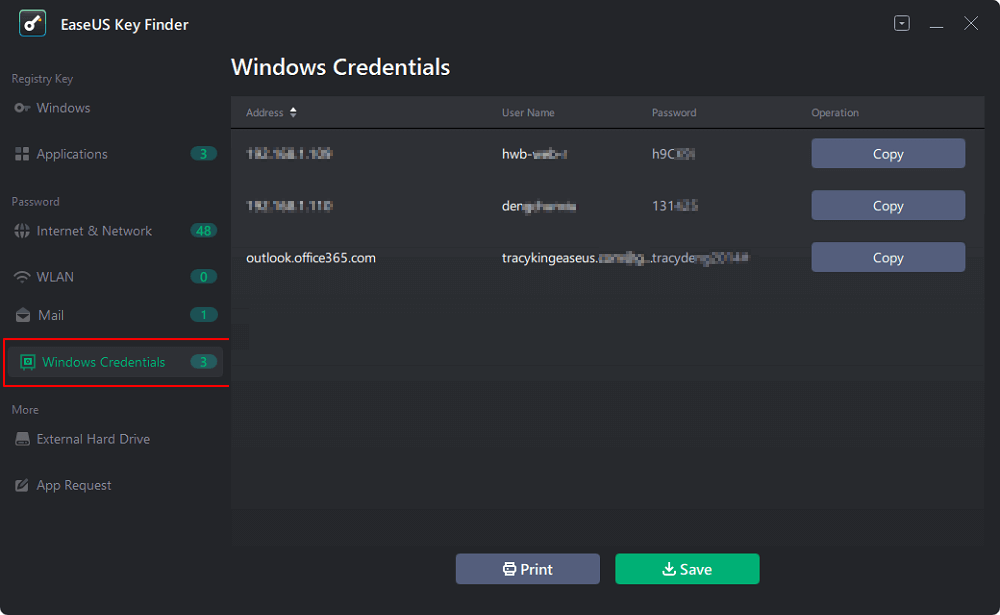
Step 2. Now, you can check all available Windows Credential addresses with respective user names, and passwords.
You can click «Copy», «Print», or «Save» these Windows Credentials’ accounts and passwords at one time.
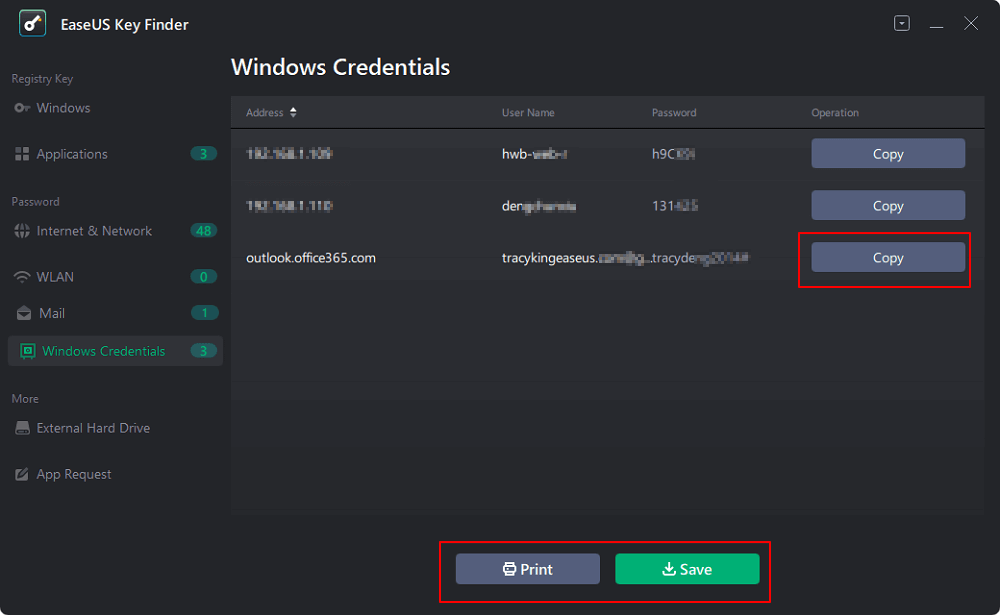
Other Features of EaseUS Key Finder
EaseUS Key Finder is a very good password finder. It also has the following powerful features:
- Recover lost product keys: It can be used to recover lost product passwords, Adobe and Microsoft Office passwords.
- Find WiFi passwords: The tool can find and recover any WiFi password on your computer.
- Find Product Key from Dead PC: If your PC is unfortunately dead or unbootable, this tool can recover the product key from a dead PC.
- Find IE accounts and passwords: It can easily display accounts and passwords stored in different web browsers such as Chrome, Edge, Firefox, and Internet Explorer.
EaseUS Key Finder can also meet more of your needs. It is a one-stop solution for password services. You can download it if you need it by clicking the link below!
Find Stored Passwords via Credential Manager
Windows Credential Manager allows users to store their usernames, passwords, and other credentials when logging in to websites. These credentials help users to automatically log in to the target web page, saving them a lot of time and effort. Here are the steps to find stored passwords using Credential Manager:
Step 1. Search for Credential Manager in the Start menu bar and open the search results.
Step 2. You will see two categories: Web Credentials and Windows Credentials. You can have the entire web credentials, as well as website passwords. You can click on Web Credentials and expand the Web Passwords option.
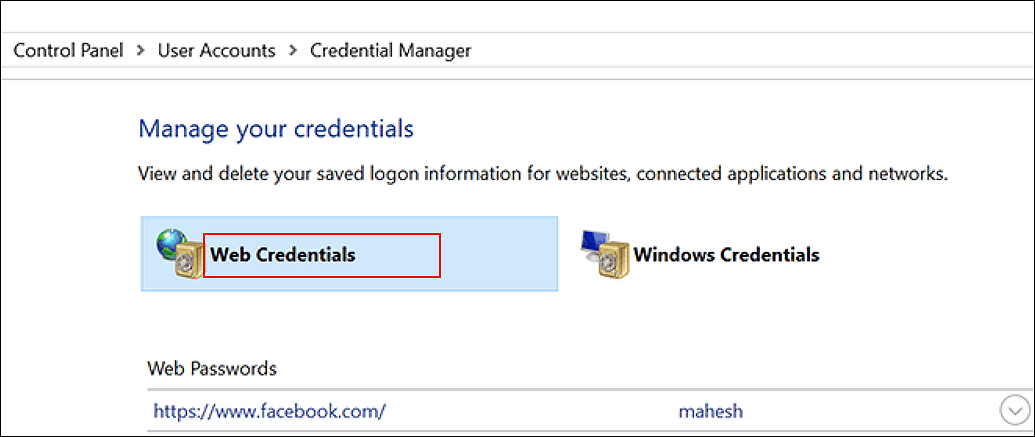
Step 3. Click «Show» and enter the Windows password used to unlock the password.
If you want to find the Windows credentials, click the option next to Web Credentials. There are fewer credentials stored there unless you enter the corporate environment.
Find Stored Passwords via Command Prompt
You can also find Administrator password Windows 10 using Command Prompt. The Command Prompt is a very powerful built-in tool for Windows. It allows you to find passwords on Windows without being able to use the Credential Manager. However, this method is only available to users familiar with the command parameters. The following is a step-by-step guide:
Step 1. Open a command line window and run it as administrator.
Step 2. Enter the command: rundll32.exe keymgr.dll,KRShowKeyMgr, and press enter.
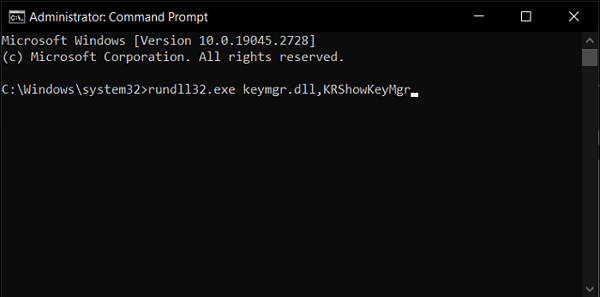
Step 3. View the Stored Usernames and Passwords window.
Find Stored Passwords via Registry Editor
The Windows registry allows you to access your administrator passwords. However, an incorrect click can seriously damage your computer’s operating system. So please be careful while operating. The following is a detailed step-by-step guide:
Step 1. Open Windows Command Prompt and type regedit, and press Enter.
Step 2. Go to HKEY_ LOCAL_MACHINE > SOFTWARE > Microsoft > Windows NT > CurrentVersion > Winlogon when the registry editor window appears.
Step 3. Scroll down to DefaultPassword and double-click it.
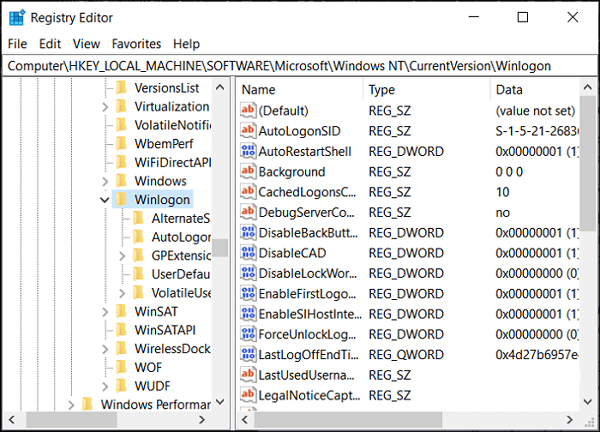
Note: There are some risks associated with this method. Tampering with the Windows registry may damage your operating system. If you are unfamiliar with this way, please choose a professional password manager.
Conclusion
On Windows 10 computers, passwords are usually stored in the registry, Windows vault, or credentials file. This article provides four ways to find stored passwords on Windows 10. Once you have lost or forgotten any specific password, you can easily retrieve it using this article’s methods. EaseUS Key Finder is a password management tool that you should not miss. If you like the method in this article, you can share it with more friends by clicking the button below.
FAQs About Stored Passwords on Windows 10
This section provides some additional topics related to how to find stored passwords on Windows 10. If you are interested, read on.
1. Can I find a stored WIFI password on Windows 10?
Yes, you can find the WiFi password. Open the Network and Sharing Center, and select your WiFi network name. In WiFi Status, select Wireless Properties, select the Security tab, and then check the Show characters checkbox. The WiFi network password is displayed in the Network Security Key box.
2. What to do if I forget my Windows 10 password?
If you forgot your password, you can reset it to log in to your account by
Step 1. On the Enter Password screen, select Reset Password to connect.
Step 2. Answer the security question.
Step 3. Enter a new password and log in with the new password.
3. How to find saved passwords via CMD?
All you need to do to retrieve your password using CMD is to familiarize yourself with the parameters for finding your password. Here are the simple steps:
Step 1. Open a command prompt window and type cmd.
Step 2. Enter the command: rundll32.exe keymgr.dll,KRShowKeyMgr, and press Enter.
В этой инструкции — о том, как сбросить забытый пароль в Windows 10 вне зависимости от того, используете ли вы учетную запись Майкрософт или локальную учетную запись. Сам процесс сброса пароля почти такой же, как те, что я описывал для предыдущих версий ОС, если не считать пары незначительных нюансов. Обратите внимание, если текущий пароль вам известен, то есть более простые пути: Как изменить пароль Windows 10.
Если эта информация потребовалась вам из-за того, что пароль Windows 10, который вы устанавливали по какой-то причине не подходит, рекомендую для начала попробовать ввести его с включенным и выключенным Caps Lock, в русской и английской раскладке — это может помочь. Если текстовое описание шагов покажется сложным, в разделе про сброс пароля локальной учетной записи также имеется видео инструкция, в которой все наглядно показано.
- Сброс пароля учетной записи Майкрософт
- Встроенное средство сброса пароля локальной учетной записи
- Как сбросить пароль Windows 10 без программ (для автономной/локальной учетной записи)
- Видео инструкция
- Изменение пароля пользователя с помощью встроенной учетной записи администратора
- Сброс пароля Windows 10 в программе DISM++
Сброс пароля учетной записи Microsoft онлайн
Если вы используете учетную запись Майкрософт, а также компьютер, на котором вы не можете войти в систему, подключен к Интернету (или вы можете подключиться с экрана блокировки, нажав по значку соединения), то вам подойдет простой сброс пароля на официальном сайте. При этом, проделать описанные шаги по смене пароля вы можете с любого другого компьютера или даже с телефона.
- Прежде всего, зайдите на страницу https://account.live.com/resetpassword.aspx, на которой выберите один из пунктов, например, «Я не помню свой пароль».
- После этого, введите адрес электронной почты (также это может быть номер телефона) и проверочные символы, после чего следуйте указаниям для восстановления доступа к учетной записи Microsoft.
- При условии, что у вас имеется доступ к электронной почте или телефону, к которому привязана учетная запись, процесс не будет сложным.
- В итоге вам останется подключиться на экране блокировки к Интернету (используя кнопку подключения справа внизу) и ввести уже новый пароль.
Если у вас нет возможности изменить пароль учетной записи Майкрософт онлайн, вы можете поступить следующим образом: перейдите к разделу инструкции про сброс пароля без программ, выполните все шаги до 10-го включительно, а затем в командной строке создайте нового локального пользователя, дайте ему права администратора и зайдите под этим пользователем, в этом поможет отдельная инструкция: Как создать пользователя Windows 10.
Сброс пароля локальной учетной записи в Windows 10 встроенными средствами
В последних версиях Windows 10 сброс пароля локальной учетной записи стал проще, чем раньше. Теперь, при установке Windows 10 вы задаете три контрольных вопроса, которые позволяют в любой момент произвести изменение пароля, если вы его забыли (но этот вариант не всегда можно использовать).
- После неправильного ввода пароля под полем ввода появится пункт «Сбросить пароль», нажмите его.
- Укажите ответы на контрольные вопросы.
- Задайте новый пароль Windows 10 и подтвердите его.
После этого пароль будет изменен и вы автоматически зайдете в систему (при условии верных ответов на вопросы). Если же вы не задавали контрольных вопросов (в этом случае вам могут сообщить, что для этой операции требуется съёмный носитель) или не знаете ответов на них, используйте следующий метод.
Сброс пароля Windows 10 без программ
Для начала о двух способах сброса пароль Windows 10 без сторонних программ (только для локальной учетной записи). В обоих случаях вам потребуется загрузочная флешка с Windows 10, не обязательно с той же версией системы, что установлена на вашем компьютере.
Первый метод состоит из следующих шагов:
- Загрузитесь с загрузочной флешки Windows 10 (Способы сделать загрузочную флешку Windows 10, придется выполнить где-то на другом компьютере), затем в программе установки нажмите клавиши Shift+F10 (Shift + Fn + F10 на некоторых ноутбуках). Откроется командная строка.
- В командной строке введите regedit и нажмите Enter.
- Откроется редактор реестра. В нем в левой панели выделите HKEY_LOCAL_MACHINE, а затем в меню выберите «Файл» — «Загрузить куст».
- Укажите путь к файлу C:\Windows\System32\config\SYSTEM (в некоторых случаях буква системного диска может отличаться от привычной C, но нужную букву легко определить по содержимому диска).
- Задайте имя (любое) для загруженного куста.
- Откройте загруженный раздел реестра (будет находиться под заданным именем в HKEY_LOCAL_MACHINE), а в нем — подраздел Setup.
- В правой части редактора реестра дважды кликните по параметру CmdLine и задайте значение cmd.exe
- Аналогичным образом поменяйте значение параметра SetupType на 2.
- В левой части редактора реестра выделите раздел, имя которого вы задавали на 5-м шаге, затем выберите «Файл» — «Выгрузить куст», подтвердите выгрузку.
- Закройте редактор реестра, командную строку, программу установки и перезагрузите компьютер с жесткого диска.
- При загрузке системы автоматически откроется командная строка. В ней введите команду net user чтобы посмотреть список пользователей.
- Введите команду
net user имя_пользователя новый_пароль
чтобы задать новый пароль для нужного пользователя. Если имя пользователя содержит пробелы, возьмите его в кавычки. Если нужно удалить пароль, вместо нового пароля введите двое кавычек подряд (без пробела между ними). Настоятельно не рекомендую набирать пароль на кириллице.
- В командной строке введите regedit и перейдите к разделу реестра HKEY_LOCAL_MACHINE\System\Setup
- Удалите значение из параметра CmdLine и установите значение SetupType равным 0.
- Закройте редактор реестра и командную строку.
В результате вы попадете на экран входа в систему, а для пользователя пароль будет изменен на нужный вам или удален.
Видео инструкция
Изменение пароля для пользователя с помощью встроенной учетной записи Администратора
Для использования данного способа, вам потребуется одно из: Live CD с возможностью загрузки и доступа к файловой системе компьютера, диск (флешка) восстановления или дистрибутив Windows 10, 8.1 или Windows 7. Я продемонстрирую использование последнего варианта — то есть сброс пароля с помощью средств восстановления Windows на установочной флешке. Важное примечание: в последних версиях Windows 10 описанный далее способ может не работать.
Первым шагом будет загрузка с одного из указанных накопителей. После загрузки и появления экрана выбора языка установки, нажмите клавиши Shift + F10 — это вызовет появление командной строки. Если ничего подобного не появляется, вы можете на экране установки, после выбора языка, слева внизу выбрать пункт «Восстановление системы», затем зайти в Устранение неполадок — Дополнительные параметры — Командная строка.
В командной строке введите по порядку команды (после ввода нажать Enter):
- diskpart
- list volume
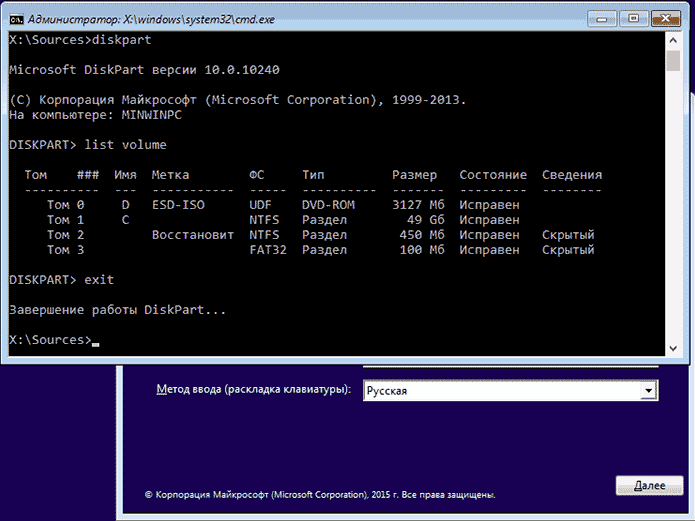
Вы увидите список разделов на жестком диске. Запомните букву того раздела (его можно определить по размеру), на котором установлена Windows 10 (это может быть не C в данный момент, при запуске командной строки из программы установки). Введите команду Exit и нажмите Enter. В моем случае это диск C, эту букву я и буду использовать в командах, которые следует ввести далее:
- move c:\windows\system32\utilman.exe c:\windows\system32\utilman2.exe
- copy c:\windows\system32\cmd.exe c:\windows\system32\utilman.exe
- Если все прошло успешно, введите команду wpeutil reboot для перезагрузки компьютера (можно перезагрузить и по-другому). В этот раз загрузитесь с вашего системного диска, а не с загрузочной флешки или диска.
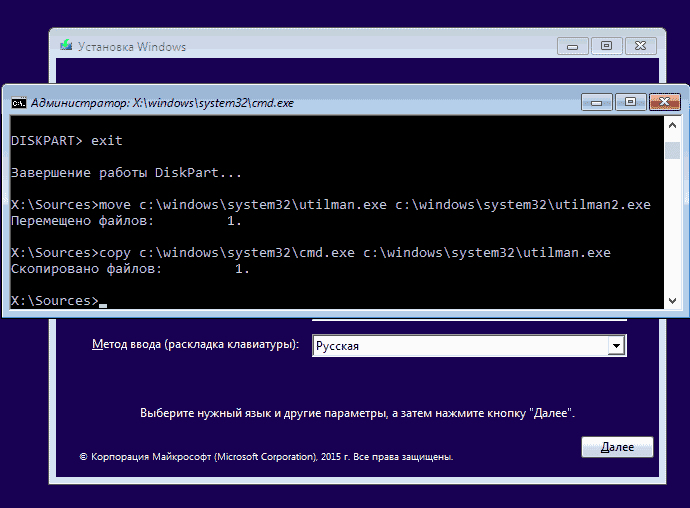
Примечание: если вы использовали не установочный диск, а что-то еще, то ваша задача с помощью командной строки, как было описано выше или другими средствами, сделать копию cmd.exe в папке System32 и переименовать эту копию в utilman.exe.
После загрузки, в окне ввода пароля, нажмите по иконке «Специальные возможности» внизу справа. Откроется командная строка Windows 10.
В командной строке введите net user имя_пользователя новый_пароль и нажмите Enter. Если имя пользователя состоит из нескольких слов, используйте кавычки. Если вы не знаете имени пользователя, используйте команду net users чтобы посмотреть список имен пользователей Windows 10. После смены пароля, вы сразу же сможете зайти под новым паролем в учетную запись.
Второй вариант сброса пароля Windows 10 (при уже запущенной командной строке, как это было описано выше)
Для использования данного способа, на вашем компьютере должна быть установлена Windows 10 Профессиональная или Корпоративная. Введите команду net user Администратор /active:yes (для англоязычной или русифицированной вручную версии Windows 10, используйте Administrator вместо Администратор).
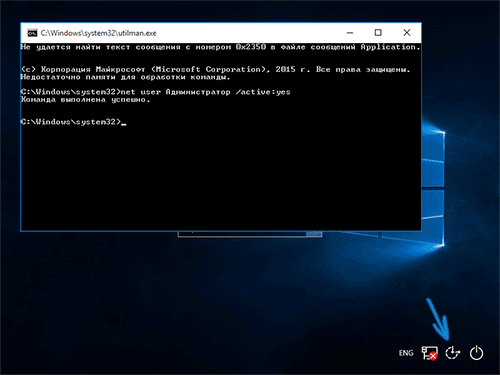
Либо сразу после успешного выполнения команды, либо после перезагрузки компьютера у вас появится выбор пользователя, выберите активированную учетную запись администратора и войдите под ней без пароля.
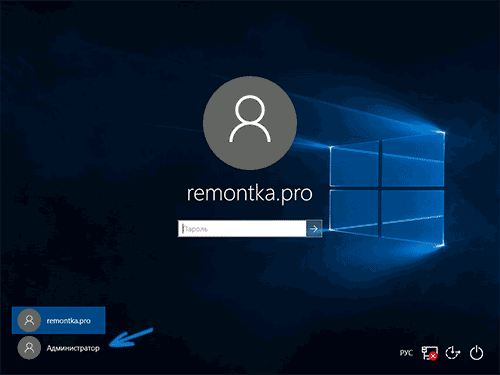
После входа (первый вход в систему занимает некоторое время), кликните правой кнопкой мыши по «Пуск» и выберите пункт «Управление компьютером». А в нем — Локальные пользователи — Пользователи.
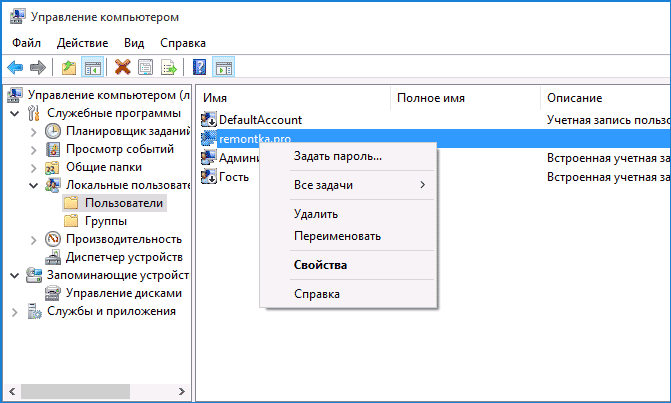
Кликните правой кнопкой мыши по имени пользователя, пароль для которого нужно сбросить и выберите пункт меню «Задать пароль». Внимательно прочитайте предупреждение и нажмите «Продолжить».
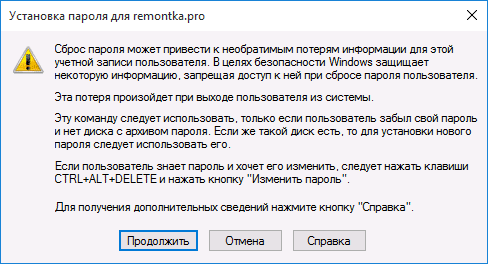
После этого задайте новый пароль учетной записи. Стоит отметить, что этот способ в полной мере работает только для локальных учетных записей Windows 10. Для аккаунта Майкрософт необходимо использовать первый способ или же, если это невозможно, войдя под администратором (как это только что было описано), создать нового пользователя компьютера.
В завершение, если вы использовали второй способ для сброса пароля, рекомендую вернуть все в первоначальный вид. Отключить встроенную запись администратора с помощью командной строки: net user Администратор /active:no
А также удалить файл utilman.exe из папки System32, после чего переименовать файл utilman2.exe в utilman.exe (если это не получается сделать внутри Windows 10, то также, как и изначально, придется зайти в режим восстановления и произвести эти действия в командной строке (как именно показано в видео выше). Готово, теперь ваша система в первоначальном виде, и вы имеете доступ к ней.
Сброс пароля Windows 10 в Dism++
Dism++ — мощная бесплатная программа для настройки, очистки и некоторых других действий с Windows, позволяющая, помимо прочего, удалить пароль локального пользователя Windows 10.
Для того, чтобы выполнить это с помощью данной программы, проделайте следующие шаги:
- Создайте (где-то на другом компьютере) загрузочную флешку с Windows 10 и на неё же распакуйте архив с Dism++.
- Загрузитесь с этой флешки на компьютере, где нужно сбросить пароль, нажмите Shift+F10 в программе установки, а в командной строке введите путь к исполняемому файлу программы в той же разрядности, что и образ на вашей флешке, например — E:\dism\dism++x64.exe. Учитывайте, что на этапе установки буква флешки может отличаться от той, что используется в загруженной системе. Чтобы посмотреть актуальную букву можно использовать по порядку команды diskpart, list volume, exit (вторая команда покажет подключенные разделы и их буквы).
- Примите лицензионное соглашение.
- В запустившейся программе обратите внимание на два пункта в верхней части: слева — Windows Setup, а справа — найденные установки Windows 10 или других версий. Нажмите по Windows 10, а затем нажмите «Открыть сессию».
- В разделе «Инструменты» — «Дополнительно» выберите «Учетные записи».
- Выберите пользователя, для которого нужно сбросить пароль и нажмите кнопку «Сброс пароля».
- Готово, пароль сброшен (удален). Можно закрыть программу, командную строку и программу установки, а затем загрузить компьютер с жесткого диска как обычно.
Подробно о программе Dism++ и о том, где её скачать в отдельной статье Настройка и очистка Windows 10 в Dism++. В случае же если ничто из описанных вариантов не помогает, возможно, вам стоит изучить способы отсюда: Восстановление Windows 10.



